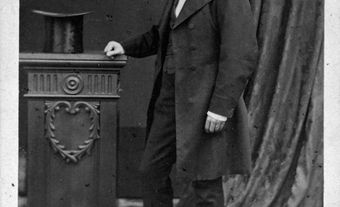Introduced in the document Option Québec (tr. An Option for Québec), written by the MSA leader René Lévesque, the expression sovereignty-association (or souveraineté-association in French) replaced the word independence and implied the idea of an association that would evolve from an agreement under international law and be limited to the economic domain (1967). In the 1970 PQ program, La Solution (1970), it is not presented as a necessary condition for Québec’s accession to sovereignty.
After the Québec referendum of 1980, the PQ’s adoption of the strategy of the beau risque, which set the sovereignty option aside, in 1984, and the election of Jacques Parizeau as leader of the Parti Québécois, the use of the expression sovereignty-association declined, and the simpler term sovereignty gained ascendancy. Within the sovereignist movement, the defenders of sovereignty-association, like those of the “go-slow” strategy, came to be regarded as the moderate wing, often described as mous (soft), as opposed to the hardline wing — the purs et durs.
Origins of Sovereignty-Association and the Referendum Strategy
René Lévesque left the Québec Liberal Party on 14 October 1967 and founded the MSA on 19 November 1967. At the time, the MSA appeared more moderate than the Rassemblement pour l’indépendance nationale (RIN), from the standpoints both of economic policy and of anticolonialist rhetoric. It was on the specific issue of association that the negotiations between the RIN and the MSA broke down. When the Parti Québécois was founded in 1968, the RIN was disbanded, and its members were invited to join the PQ as individuals.
Starting with the PQ congress in 1974, sovereignty-association became linked with the go-slow strategy proposed by Claude Morin. First, the Parti Québécois set aside the option of an independence election leading to sovereignty without a referendum. So as not to frighten voters, the PQ instead committed to holding a referendum once it had assumed power. Then a third step was added, making two referendums necessary: a first giving the Québec government the authority to negotiate with the rest of Canada, and a second leading to sovereignty.
Doctrine of Sovereignty-Association
In October 1978, Premier Lévesque declared in the National Assembly that Québec had to radically transform its union with the rest of Canada, and that sovereignty and association should come about "smoothly and simultaneously." In what came to be called the White Paper on Sovereignty-Association (La nouvelle entente Québec-Canada), the PQ government claimed that "sovereignty is indissolubly linked with association."
The document went on to describe the doctrine more fully: it foresaw a common monetary system with the rest of Canada, coupled with a reorganization of the tasks of the present Bank of Canada into new common institutions, including a central monetary authority. It also presupposed a joint free-trade zone and a common external tariff (though each of the two communities could protect its own agriculture). It allowed for the free passage of goods and persons between Québec and Canada, and a variety of special agreements concerning jobs and immigration. A community council, composed of an equal number of ministers from each side and presided over alternately by a Canadian and a Québécois, would settle any disputes that might arise.
Three other Québec-Canada institutions were proposed: a committee of experts to serve (under the council) as general secretariat to the community; a court of justice consisting of an equal number of Québec and Canadian judges with exclusive jurisdiction over the interpretation and workings of the association treaty; and a joint monetary authority responsible for the management of the single exchange rate, but not for the debt of the two sovereign partners (each would handle its own). Sovereignty-association, in the view of the White Paper, was not an end in itself, but a means by which Québec could freely direct its own affairs. Québec would thus enjoy the economic advantages of the federal union and the benefits of political independence.
Decline of Sovereignty-Association
In May 1980, the Parti Québécois government used a referendum to ask the people of Québec for a mandate to negotiate sovereignty-association, thus defined, with the federal and other provincial authorities. The PQ lost the vote (60 per cent to 40 per cent). In 1984, after consultation with its membership, the PQ decided to put aside this option, and not make it the party’s platform in the next election. The beau risque (bold risk) was a constitutional reform strategy championed by René Lévesque and made possible by the election of the Conservative government of Brian Mulroney in Ottawa. This strategy led to internal dissent, and a group of dissidents faithful to the party’s basic objective, including Jacques Parizeau, decided to leave. At the urging of the PQ’s new leader, Pierre-Marc Johnson, the party adopted the concept of “national affirmation” in the first article of its program, doing away with the concept of sovereignty-association. The PQ subsequently lost the Québec election of 1985.
The PQ’s referendum strategy evolved considerably after Jacques Parizeau became party leader in 1988. The term sovereignty was retained without being linked to the term association. In the Québec referendum of 1995, the question asked no longer mentioned association, but instead proposed an economic and political partnership with the rest of Canada. Unlike the conditions in the 1980 referendum, in the 1995 referendum, Québec could have acceded to sovereignty if the Yes side had won and negotiations with Canada had subsequently failed. Thus sovereignty-partnership would appear to be defined more as a form of political independence, whereas sovereignty-association meant a new agreement on Confederation.
See also French Canadian nationalism; Separatism; Constitutional History.

 Share on Facebook
Share on Facebook Share on X
Share on X Share by Email
Share by Email Share on Google Classroom
Share on Google Classroom





